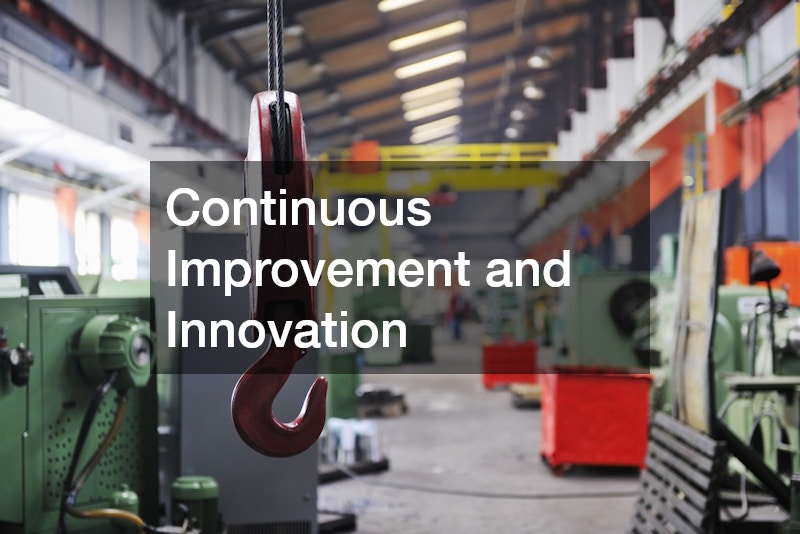Industrial efficiency is the backbone of successful manufacturing and production operations. By reducing waste and optimizing output, businesses can save time, cut costs, and improve sustainability. From streamlining workflows to implementing advanced technology and employee training programs, every aspect of operations plays a role in overall efficiency. This guide explores best practices that industrial companies can adopt to enhance productivity, minimize resource waste, and create a more resilient, high-performing business.

Understanding Industrial Efficiency
Efficiency in industrial operations is more than just reducing costs; it’s about optimizing processes to ensure that every resource is used effectively. Businesses that fail to focus on efficiency often experience higher operational expenses, slower production timelines, and increased waste. Implementing best practices can dramatically improve both productivity and sustainability. Identifying areas where waste can be minimized is the first step toward building a more streamlined operation. From production scheduling to equipment utilization, understanding how every part of the operation contributes to output allows managers to make informed decisions. For instance, tracking and maintaining waste equipment regularly can prevent unnecessary downtime and environmental impact, which ultimately saves money and improves output.
Leveraging Data Analytics for Efficiency
Data-driven decision-making is increasingly essential in modern industrial operations. By leveraging data analytics, businesses can monitor production performance, identify inefficiencies, and make informed adjustments in real-time. Collecting and analyzing data from machinery, supply chains, and workflow processes allows managers to detect patterns that contribute to wasted resources or downtime. Implementing predictive analytics tools helps anticipate issues before they occur, optimize scheduling, and allocate resources more effectively. Utilizing data analytics empowers industrial companies to continuously refine operations, boost output, and maintain a competitive edge while minimizing waste and operational costs.
Adopting Modern Technology
Technology plays a critical role in enhancing industrial efficiency. Investing in modern equipment and monitoring systems allows businesses to optimize production while minimizing energy consumption. For example, upgrading heating systems in facilities can result in significant energy savings. Installing a Rheem RTEX 13 electric tankless water heater for facility needs ensures that energy is used only when necessary, reducing wasted heat and lowering utility costs. By integrating smart technology into day-to-day operations, managers can also track usage patterns, predict maintenance needs, and reduce operational delays. This approach not only improves efficiency but also supports a sustainable business model, aligning with environmental standards and reducing overall operational waste.
Strategic Planning and Risk Assessment
Industrial efficiency is closely linked to proper planning and risk management. Without a clear strategy, companies risk production bottlenecks, material shortages, and costly downtime. A proactive approach involves evaluating all processes and identifying potential areas of failure. Implementing outsourcing and risk management strategies can alleviate these pressures by allowing specialized third-party providers to handle non-core tasks, mitigating risks associated with delays and human error. Effective outsourcing also ensures that in-house teams focus on high-value tasks, which enhances overall productivity. By understanding the risks involved and planning accordingly, industrial businesses can maintain smooth operations, reduce wasted time and resources, and increase overall output.

Optimizing Production Lines
Production efficiency hinges on the effectiveness of the manufacturing line. Businesses should conduct regular audits to assess bottlenecks, workflow interruptions, and equipment performance. Investing in advanced manufacturing equipment not only improves production speed but also ensures consistency and precision, reducing the chances of defective products. Additionally, routine maintenance of machinery prevents breakdowns that can halt operations and waste raw materials. By analyzing production metrics and integrating automated processes where appropriate, industrial companies can maximize throughput while minimizing operational inefficiencies. The right combination of technology, skilled personnel, and process monitoring is key to sustaining a high-output, low-waste production environment.
Handling Heavy Loads Safely
In industrial settings, moving and handling heavy materials efficiently is crucial to maintaining workflow and preventing workplace injuries. Investing in top heavy lifting solutions can make a significant difference in both safety and productivity. Equipment such as cranes, hoists, and hydraulic lifts allow teams to move large objects with precision and speed, reducing downtime caused by accidents or manual handling limitations. Proper training and regular inspection of lifting equipment further ensure that operations remain smooth. Efficient material handling not only protects employees but also reduces the risk of damaged products and lost time, contributing directly to higher output and better overall efficiency within industrial facilities.
Efficient Material Management
Keeping track of materials is essential to avoid unnecessary waste and ensure uninterrupted production. Over-ordering or misplacing materials can lead to significant financial losses. Companies should implement inventory management systems and establish clear protocols for handling incoming and outgoing supplies. For instance, sourcing building supplies strategically from reliable vendors helps maintain adequate stock without overstocking. Organizing storage areas, monitoring usage patterns, and training staff on proper handling practices reduces material loss and prevents disruptions. By maintaining control over materials and ensuring timely availability, industrial operations can sustain continuous production and improve overall efficiency.
Streamlining the Supply Chain
A strong supply chain is the backbone of efficient industrial operations. Delays in material delivery or miscommunication between suppliers can halt production and create unnecessary waste. Partnering with a dependable supply chain company ensures that raw materials and components arrive on time and meet quality standards. Implementing transparent communication channels and real-time tracking systems can further enhance coordination, reducing the risk of delays. A robust supply chain not only improves operational efficiency but also strengthens relationships with vendors and clients, creating a reliable flow of resources that allows businesses to focus on maximizing output without worrying about disruptions or shortages.

Maintaining Equipment Effectively
Well-maintained equipment is critical for smooth industrial operations. Unexpected machinery breakdowns lead to production delays and wasted materials. Hiring skilled professionals, such as a qualified forklift mechanic, ensures that essential vehicles and machines are serviced regularly and repaired promptly. Preventive maintenance schedules, routine inspections, and timely repairs minimize downtime and extend equipment lifespan. Well-maintained machinery also operates more efficiently, consuming less energy and reducing operational costs. By prioritizing maintenance and investing in skilled technicians, industrial businesses can sustain high productivity levels while reducing unnecessary waste from inefficient or malfunctioning equipment.
Leveraging Equipment Flexibility
Industrial operations often face fluctuating demand, making it important to have flexible access to necessary tools and machinery. Partnering with an equipment rental company allows businesses to scale resources according to project requirements without the long-term financial commitment of purchasing equipment outright. This approach helps reduce idle machinery, lowers maintenance costs, and ensures that operations remain agile and responsive to changing production needs. By renting specialized tools for temporary or high-demand projects, companies can maintain efficiency, minimize resource wastage, and optimize output while keeping capital expenditures under control.
Effective Project Management
Managing industrial projects efficiently requires coordination between multiple teams and stakeholders. Hiring a reputable industrial contractor ensures that projects are executed on time, within budget, and to required specifications. Experienced contractors bring expertise in planning, scheduling, and quality control, reducing the likelihood of delays or errors that lead to wasted materials. Clear communication and defined responsibilities across teams further improve project efficiency. By leveraging the skills and experience of industrial contractors, companies can achieve higher-quality results, maintain continuous workflow, and enhance overall productivity, ultimately contributing to a more efficient and profitable industrial operation.
Employee Training and Engagement
Industrial efficiency is not solely dependent on technology and equipment; it also relies on the workforce. Properly trained employees understand best practices, operate machinery safely, and follow protocols that reduce errors and waste. Continuous training programs, combined with employee engagement initiatives, encourage staff to identify inefficiencies and suggest improvements. By fostering a culture of responsibility and efficiency, companies can ensure that personnel contribute positively to output while minimizing mistakes. Motivated and knowledgeable employees are instrumental in maintaining high production standards and achieving long-term operational efficiency.

Continuous Improvement and Innovation
Efficiency in industrial operations is an ongoing pursuit. Businesses must regularly assess processes, adopt new technologies, and implement innovative strategies to remain competitive. Techniques such as lean manufacturing, process re-engineering, and data-driven decision-making allow companies to identify areas of improvement and eliminate waste systematically. Encouraging cross-department collaboration and investing in research and development can uncover solutions that increase output without increasing costs. By embedding continuous improvement into the company culture, industrial organizations can sustain high efficiency, reduce waste consistently, and adapt to evolving market demands, ensuring long-term success.
Implementing Lean Inventory Practices
One of the most effective ways to increase efficiency in industrial operations is by adopting lean inventory practices. Maintaining excessive stock ties up capital and increases the risk of obsolescence, while insufficient stock can halt production. By analyzing consumption patterns and using demand forecasting tools, businesses can optimize inventory levels to meet production needs without creating waste. Just-in-time strategies, combined with automated tracking systems, allow teams to reorder materials precisely when needed, minimizing storage costs and improving cash flow. Lean inventory practices also encourage better communication between procurement, production, and warehouse teams, ensuring that every department is aligned and that materials are utilized efficiently. Overall, this approach enhances productivity and reduces both operational and environmental waste.
Enhancing Energy Efficiency
Energy consumption is a significant operational cost in industrial settings. Implementing energy-efficient solutions can reduce expenses while contributing to sustainability goals. Regularly auditing facilities and identifying areas where energy is wasted helps managers make informed improvements. For example, upgrading lighting to LED systems, optimizing HVAC schedules, and improving insulation can lower energy consumption. Additionally, incorporating energy-efficient machinery and monitoring energy usage in real-time allows businesses to detect inefficiencies quickly. By focusing on energy efficiency, companies not only reduce utility costs but also decrease their carbon footprint, making their operations more sustainable and aligned with modern environmental standards. Energy-efficient processes ultimately support long-term industrial efficiency and higher output.
Optimizing Workforce Scheduling
Efficient workforce management is essential to maximizing output while minimizing downtime. Scheduling employees according to peak production times and skill sets ensures that labor resources are used effectively. Cross-training employees to perform multiple roles increases flexibility and reduces delays caused by absenteeism or unexpected demand spikes. Monitoring productivity and analyzing workflow bottlenecks can highlight areas for improvement in staffing allocation. Implementing workforce management software allows managers to forecast labor needs accurately and adjust schedules dynamically. Optimized workforce scheduling not only boosts efficiency but also enhances employee satisfaction by preventing overwork and reducing idle time, which in turn leads to higher overall productivity and lower operational waste.
Reducing Material Handling Errors
Material handling is a critical aspect of industrial efficiency. Errors in moving, storing, or processing materials can lead to production delays, safety hazards, and unnecessary waste. Implementing standardized handling procedures, providing adequate training, and utilizing proper equipment are key steps in minimizing mistakes. Automated tracking systems can help monitor inventory movement in real-time, reducing misplaced items and ensuring materials are available when needed. Labeling systems and organized storage layouts further improve accuracy and speed. By reducing material handling errors, companies can prevent damage to products, save time, and maintain a smoother production flow, all of which contribute to higher efficiency and reduced operational costs.

Investing in Predictive Maintenance
Unexpected equipment failures can significantly disrupt production and create costly downtime. Predictive maintenance uses sensors, data analytics, and machine learning to monitor equipment conditions and predict potential failures before they occur. This approach allows maintenance teams to perform repairs at optimal times, avoiding unnecessary interruptions in production. Predictive maintenance extends the life of machinery, reduces emergency repair costs, and minimizes wasted materials caused by malfunctioning equipment. By investing in this proactive strategy, industrial businesses can maintain consistent output levels, improve operational efficiency, and ensure the reliability of critical machinery. The long-term benefits include lower maintenance expenses and a more productive workforce.
Maximizing industrial efficiency requires a holistic approach that balances technology, workforce management, and process optimization. By adopting these best practices, businesses can reduce waste, prevent downtime, and maintain consistent production quality. Continuous improvement, strategic planning, and proper resource management ensure that operations remain agile and productive. Companies that focus on efficiency not only enhance profitability but also build a sustainable foundation for long-term growth and competitiveness in the industrial sector.
